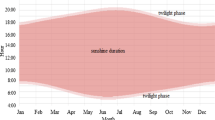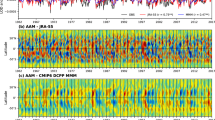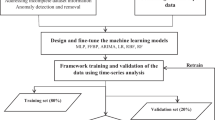Abstract
The general regression neural network (GRNN) model was proposed to model and predict the length of day (LOD) change, which has very complicated time-varying characteristics. Meanwhile, considering that the axial atmospheric angular momentum (AAM) function is tightly correlated with the LOD changes, it was introduced into the GRNN prediction model to further improve the accuracy of prediction. Experiments with the observational data of LOD changes show that the prediction accuracy of the GRNN model is 6.1% higher than that of BP network, and after introducing AAM function, the improvement of prediction accuracy further increases to 14.7%. The results show that the GRNN with AAM function is an effective prediction method for LOD changes.
Similar content being viewed by others
References
EUBANKS T M. Variations in the orientation of the earth [M]. Washington, DC: AGU Press, 1993: 1–54.
YE Shu-hua, HUANG Cheng. Astro-geodynamics [M]. Jinan: Shandong Science and Technology Press, 2000: 26–31, 466–467. (in Chinese)
ZHOU Yong-hong, SALSTEIN D A, CHEN J L. Revised atmospheric excitation function series related to Earth’s variable rotation under consideration of surface topography [J]. Journal of Geophysical Research, 2006, 111(D12): D12108-1–D12108-11.
WANG Qi-jie, LIAO De-chun, ZHOU Yong-hong. Real-time rapid prediction of variations of Earth’s rotational rate [J]. Chinese Science Bulletin, 2008, 53(7): 969–973.
AKYILMAZ O, KUTTERER H. Prediction of earth rotation parameters by fuzzy inference systems [J]. Journal of Geodesy, 2004, 78: 82–93.
CHAO B F. On the excitation of the Earth’s polar motion [J]. Geophysical Research Letters, 1985, 12(8): 526–529.
KOSEK W, MCCARTHY D D, LUZUM B J. Possible improvement of Earth orientation forecast using autocovariance prediction procedures [J]. Journal of Geodesy, 1998, 72: 189–199.
FREEDMAN A P, STEPPE J A, DICKEY J Q. The short-term prediction of universal time and length of day using atmospheric angular momentum [J]. Journal of Geophysical Research, 1994, 99(B4): 6981–6996.
SCHUH H, ULRICH M, EGGER D. Prediction of Earth orientation parameters by artificial neural networks [J]. Journal of Geodesy, 2002, 76: 247–258.
SPECHT D F A. General regression neural network [J]. IEEE Transactions on Neural Networks, 1991, 2: 568–576.
HE Yong-xiu, HE Hai-ying, WANG Yue-jin, LUO Tao. Forecasting model of residential load based on general regression neural network and PSO-Bayes least squares support vector machine [J]. Journal of Central South University of Technology, 2011, 18: 1184–1192.
GUO Bin, MENG Ling-qi, DU Yong, MA Sheng-biao. Thickness prediction of medium plate mill based on GRNN neural network [J]. Journal of Central South University: Science and Technology, 2011, 42(4): 960–965. (in Chinese)
ABDULLATIF E B N, MAHMOUD M A. Cooling load prediction for buildings using general regression neural networks [J]. Energy Conversion and Management, 2004, 45: 2127–2141.
TOMOKO N. Using general regression and probabilistic neural networks to predict human intestinal absorption with topological descriptors derived from two-dimensional chemical structures [J]. Journal of Chemical Information and Modeling, 2003, 43(1): 113–119.
WANG Qi-jie, LIAO De-chun, ZHOU Yong-hong, LIAO Xin-hao. The important role played by atmospheric angular momentum in the non-linear prediction of the variations in the Length of Day [J]. Chinese Astronomy and Astrophysics, 2008, 32: 342–349.
MCCARTHY D D, PETIT G. IERS convention (2003) [R]. Paris: International Earth Rotation and Reference Systems Service, 2003.
Author information
Authors and Affiliations
Corresponding author
Additional information
Foundation item: Projects(U1231105, 10878026) supported by the National Natural Science Foundation of China
Rights and permissions
About this article
Cite this article
Wang, Qj., Du, Yn. & Liu, J. Introducing atmospheric angular momentum into prediction of length of day change by generalized regression neural network model. J. Cent. South Univ. 21, 1396–1401 (2014). https://doi.org/10.1007/s11771-014-2077-2
Received:
Accepted:
Published:
Issue Date:
DOI: https://doi.org/10.1007/s11771-014-2077-2




